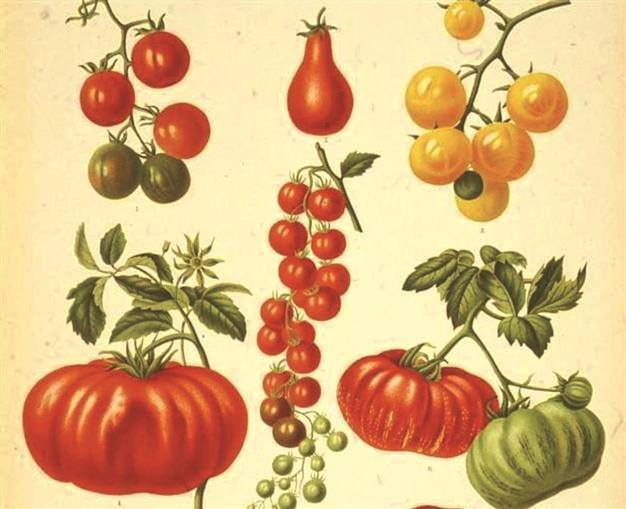French Connection?
AYLİN ÖNEY TAN - aylinoneytan@yahoo.com
 What do tomatoes and the French have in common? French cookery is certainly not bathed in garish red sauces like the Italian kitchen. France might actually rank at the bottom in the whole Mediterranean world in making the least use of tomatoes and tomato paste. Strangely, we attribute a French connection to tomatoes! Few can remember now, but we used to call tomatoes “Frenk,” meaning French.
What do tomatoes and the French have in common? French cookery is certainly not bathed in garish red sauces like the Italian kitchen. France might actually rank at the bottom in the whole Mediterranean world in making the least use of tomatoes and tomato paste. Strangely, we attribute a French connection to tomatoes! Few can remember now, but we used to call tomatoes “Frenk,” meaning French. I stumbled upon the puzzle when I was working in the south-east years ago. The ubiquitous kebabs sometimes bore an odd “Frenk” attribute; however, there was not even a clue of a smothering béchamel sauce or an oozing melting cheese topping, the two typical Westernization influences. However, in Urfa and Gaziantep, people decidedly differentiated which kebabs to call French, but nobody seemed to be aware of the origin of this peculiar attribution. The penny dropped for me when I was doing another research on the complete opposite side of the country. While studying the Sephardic Jews’ methods of making food in Kırklareli in Thrace, a favorite recipe stood out: ‘Frenkes Yenas,’ that is ‘Stuffed Tomatoes.’ There it was: the French connection finally obvious! Indeed ‘frenkes’ were tomatoes, and the southeastern “Frenk” kebabs were of course all with tomatoes. Simply remembering other French nicknamed things in Turkish cookery, like chervil, lime, red currants, any novelty not native to the land was nick-named French. In Turkey, we’ve always had a tendency to call anything coming from the West simply as French, usually referring also to modernity. The Western lifestyle, chic and modern was “Alla Franca,” or eventually rolled into “Alafranga,” and that was the way to go in 19th century.
So tomatoes once were very “alafranga,” a truly strange Western oddity, initially used only when green. The Sephardic Jews, having close trading connections to the West, were among the pioneers to adopt novelties, and the lovely “Frenkes Yenas” was made with green tomatoes. We know the tomato made its appearance in Topkapı Palace initially in the green form, mostly not used for cooking, but for pickles. Early cookbooks and Istanbul residents used to call tomato paste not “salça,” derived from salsa, as it is called today, but “reçel,” meaning jam. Well jam making was a preservation technique after all. Funnily, some old folks down on the Syrian border still call tomato paste “domates pekmezi;” “pekmez,” being the name for molasses. Obviously, the process of reducing down the tomato pulp was likened to that of reducing grape juice to make molasses and the salty savory paste was named just like the sticky sweet grape molasses.
The Anatolian soil and sun welcomed the tomato open heartedly and made the once-novelty a true native. Now, Turkish cookery is practically dyed in the striking coral red of the tomato. Embracing tomato as a native, people have long forgotten about how a true stranger it was, but some kebabs in once French-occupied Urfa and Gaziantep are still called “Frenk!”
Recipe of the Week: Our recipe is simple, bold and strong. This classic recipe from Italy is made famous by Marcella Hazan, author of several cookbooks on Italian cuisine. She has been influential and a pioneer in making Italian cooking accessible to home-cooks in America. When she passed away last September, her hit tomato sauce recipe was much raved about on the internet and the media. The trick is simple: it’s just tomatoes, butter and an onion. The reason that I picked this is now that the season for sun-ripe tomatoes is over; this recipe makes use of tinned tomatoes. Just empty a can of 800 g tinned tomatoes in a casserole, add a whole peeled onion cut crosswise and 75 g butter (about 5 tablespoons). Salt to flavor. Simmer for about 45-50 minutes, or until the sauce thickens and the butter pools away from the tomatoes. Stir occasionally, and if using whole peeled tomatoes, crush them from time to time using back of a spoon pushing against to the side of the pan. This sauce is best with bold pasta types like penne, and rigatoni. The sweetness of butter & onions and the acidity of tomatoes are perfectly balanced in this sauce, and the final taste will be astonishingly reminiscent of Iskender kebap, perhaps because of all the buttery goodness and the tomato splash of the famous Turkish dish.
Bite of the week
Fork of the Week: There are so many bottled or canned tomatoes in the
market. All are very good indeed, even the no-brand market labels. A new
bottled tomato haunted me by its name, simply called “Sadece Domates”
by Kilye, translated as “Just Tomatoes”. It is simply crushed or whole
peeled tomatoes in their own juice, but nothing else. You can use them
in Marcella’s recipe, or in any other sauce, or as suggested by them,
together with fried eggs for a superb Sunday breakfast. Kilye is the
sister producer of Suvla wines in Gallipoli, and the tomatoes of the
Çanakkale region are legendary, so it is worth trying them, along with a
good bottle of Suvla.
Cork of the Week: Kabatepe Red 2011 by Suvla is a balanced bodied table
wine with intensely fruity and savory aromas, just like the tomato
savory fruitiness of the tomato, hence a true match for Marcella’s
buttery sweet-tart pasta sauce. Though the very Turkish name refers to
the hills of the vineyards, the grapes are a mix of all French
novelties: Cabernet Sauvignon, Merlot, Syrah, Cabernet Franc and Petit
Verdot, apparently all adapted to Gallipoli soil so well, the wine
received 87 points in Masters of Wine 2013 Istanbul.












